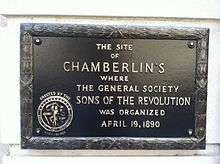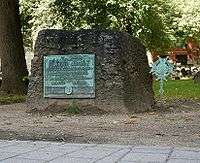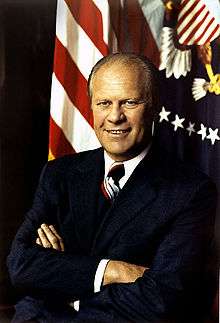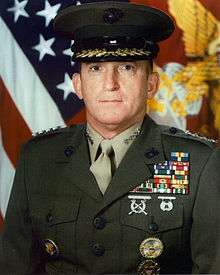Sons of the Revolution

Sons of the Revolution (SR) is a hereditary fraternal organization which was founded in 1876 and educates the public about the American Revolution. The General Society Sons of the Revolution is the SR's national organization and is a Pennsylvania non-profit corporation.[1][2] Located at Williamsburg, Virginia, it is governed by a board of managers, an executive committee, officers, standing committees and their members, and staff. The general society includes 28 state societies and 14 chapters in the United States, as well as societies in France and Mexico.[3] It describes its purpose as:
"[T]o perpetuate the memory of the men, who in the military, naval and civil service of the Colonies and of the Continental Congress by their acts or counsel, achieved the Independence of the Country, and to further the proper celebration of the anniversaries of the birthday of Washington, and of prominent events connected with the War of the Revolution; to collect and secure for preservation the rolls, records, and other documents relating to that period; to inspire the members of the Society with the patriotic spirit of the forefathers; to promote the feeling of friendship among them."[4]
Sons of the Revolution should not be confused with Sons of the American Revolution (SAR), a separate organization which was founded on April 30, 1889 at New York by the New Jersey businessman William Osborn McDowell. He disagreed with the Sons of the Revolution requirement of the time that other state societies be subordinate to the founding New York society. In addition, McDowell intended to include a wider base of members by recognizing additional types of public service of a revolutionary ancestor beyond military service during the Revolution.[5]
Membership
Today SR membership is open to:
"Any male person above the age of eighteen years, of good character, and a descendant of one who, as a military, naval, or marine officer, soldier, sailor or marine, in actual service, under the authority of the original thirteen Colonies or States or of the Continental Congress, and remaining always loyal to such authority, or a descendant of one who signed the Declaration of Independence, or of one who, as a member of the Continental Congress or of the Congress of any of the Colonies or States, or as an official appointed by or under the authority of any such legislative bodies, actually assisted in the establishment of American Independence by services rendered during the War of Revolution, becoming thereby liable to conviction of treason, against the government of Great Britain, but remaining always loyal to the authority of the Colonies or States, or who served honorably in a military or naval expedition against the British during the War of the Revolution under the authority of the French or Spanish governments...."[4]
Junior, senior and life memberships are also available. Members receive benefits[6][7] which include:
- Invitation to general-society, state-society and chapter events, including the triennial meetings and the annual Let Freedom Ring celebrations;
- Issues of the general-society quarterly Drumbeat newsletter and the semiannual Flintlock & Powderhorn magazine; and
- Availability of accoutrements, including membership certificate, rosette, formal and informal insignia, and other regalia.
History
Founding
Sons of the Revolution was founded on February 22, 1876 at New York City, primarily by leading members of The Society of the Cincinnati and the businessman John Austin Stevens. He disagreed with Society of the Cincinnati requirements limiting membership to the eldest male descendants based on the rules of primogeniture. He intended to have SR include members by recognizing any descendant of a revolutionary ancestor.[8] Stevens held a preliminary meeting on December 18, 1875 at the New-York Historical Society at New York.[9] At a second meeting held in January 1876, the first SR constitution was adopted and a flier which invited members was published.
The fledgling group languished for several years until December 4, 1883 when it held an elaborate "turtle feast" dinner in the Long Room of Fraunces Tavern. Located in the historic tavern in lower Manhattan, the banquet was to commemorate the centennial of the dinner and speech of General George Washington where he bade farewell to his officers of the Continental Army in the room.[10][11][12][13] The 1883 dinner helped recruit 40 new members, and the group was reorganized as the Sons of the Revolution in the State of New York Inc. In the early years after the reorganization, Society of the Cincinnati President-General Hamilton Fish gave much support and encouragement to the New York society. He referred often to its members as the "younger brothers of the Cincinnati."
Founding of the Sons of the American Revolution
About 1888, SR member William Osborn McDowell began to organize chapters of the SR in several states. McDowell saw the potential for the SR to become a mass movement as there were hundreds of thousands of Americans who were descendants of Patriots who had served the cause of independence from Great Britain during the American Revolution.
McDowell's vision for the SR conflicted greatly with that of its founders in that the founders saw the SR as being an exclusive society of gentlemen of social standing. Furthermore, they stipulated that societies in other states would have to be subordinate to the New York Society. This requirement was unacceptable to McDowell and, in response, McDowell organized a separate organization called the Sons of the American Revolution (SAR) on April 30, 1889 at Fraunces Tavern. The next year, McDowell was instrumental in the founding of the Daughters of the American Revolution (DAR).
In the years following the founding of the SAR, there were several attempts to reconcile the two organizations but they were unable to overcome their differences.
General Society formation
Recognizing that SR members from states other than New York might form state societies in their states, the group's officers amended its constitution in 1884 to provide that state societies may organize as "auxiliary branches." Consequently, the Pennsylvania society was formed in 1888, and the District of Columbia society was formed in 1889.
The General Society constitution was proposed on February 12, 1890 in Philadelphia and adopted on March 8, 1890 in New York. Members of the three state societies held a meeting on April 19, 1890 in Washington to inaugurate the General Society. In the next few years, several more state societies were formed and the General Society developed a more national character.
Activities
The General Society and state societies offer patriotic, historical and educational activities for its members and the public. In addition to various dinners, exhibits and holiday events, the societies produce the following specific activities. Several state societies own and operate historic buildings.
Triennial general meetings
Since its founding, the General Society has held triennial meetings of the membership. The 41st meeting was held on October 4 through 7, 2012 in Savannah, Georgia, by the Georgia society.
Citizen awards
The General Society has established various citizen awards, given to individuals and state societies for their work to continue the SR mission and honor the memory of the participants of the Revolution. The awards include the Modern Patriot Award, the Patrick Henry Award, the Jay Harris Award, the Richard Farmer Hess Leadership Award, the Trent Trophy, the Membership Achievement Award and the Presidential Commendation of Merit.
The 2012 Modern Patriot Award, symbolized by a Paul Revere bowl, was presented to Janet Uhlar of Rhode Island.[14]
Fraunces Tavern
Since 1904, the New York SR society has owned an operated the Fraunces Tavern as a museum and restaurant. They restored the building, which had a prominent place in pre-Revolution and Revolution history. The society claims the tavern is Manhattan's oldest surviving building.[15]
The Fraunces Tavern Museum maintains several galleries of art and artifacts about the Revolution, including the McEntee "Sons of the Revolution" Gallery that displays much of the SR history.[16]
Green End Fort
The Rhode Island society has maintained Green End Fort, in the Village of Green's End on the border of Newport and Middletown, since 1969 when its owner, Newport Historical Society, "expressed hope that the Sons would 'maintain the Fort as a memorial and eventually acquire the property.'" The fort was believed to have been built in 1777 by British troops as part of the defenses of Newport, but more recent scholarship indicates it was probably built by the French army under Comte de Rochambeau in 1780.[17]
Grave-marker and wreath placements

Several state societies have placed SR markers and wreaths at the graves of identified revolutionary patriots; for instance, the Massachusetts society placed markers at the graves of Samuel Adams and James Otis Jr., which are located in the Granary Burying Ground at Boston. The General Society joined the Georgia society in 2005 to place a wreath at the re-interment of U.S. Brig. Gen. Casimir Pulaski in Savannah, Ga.[18]
"Let Freedom Ring" celebrations
Since July 4, 1969, the Pennsylvania society has sponsored "Let Freedom Ring," the nationwide celebration of those who helped achieve the nation's independence during the Revolution.[19][20][21] According to U.S. Senate Concurrent Resolution 25 of 1963, bells across the nation are rung 13 times at exactly 2:00 p.m. EDT in honor of the 13 original states represented by the signers of the Declaration of Independence. At the appointed hour, four young descendants of the signers tap Philadelphia's famous Liberty Bell, setting off the chimes of freedom from bell towers throughout the nation. A series of related patriotic festivities take place in the Independence Hall area, including a colorful parade of Revolutionary War flags, fifes and drums, and a wreath-laying ceremony at the Tomb of the Unknown Soldier of the Revolutionary War at Washington Square.[22]
Military awards
The General Society and several state societies have established various educational and military awards, which are given to individuals and groups for their academic or service performance. The awards include the Annapolis Cup, which was created in 1905 and given annually by the general society and the Maryland society to a U.S. Naval Academy midshipman;[23] the Knox Trophy (New York), which was created in 1910 and given annually by the New York society to a U.S. Military Academy at West Point cadet;[24] the Capt. Gustavus Conyngham Award which was created in 1999 and given annually by the New York society to a U.S. Merchant Marine Academy at Kings Point midshipman;[24] the Recognition Award, which was created in 2002 and given annually by the Massachusetts society to a U.S. Army ROTC cadet;[25] and the Knox Trophy (Massachusetts), which was created in 1924 and given annually until 1940 by the Massachusetts society to a U.S. Army field-artillery battery and a "redleg" artilleryman.[26]
Evacuation Day observances
The New York society has organized infrequent Evacuation Day observances of the anniversary of the British departure on November 25, 1783 from New York after the Revolution. After a controversial New York Police Department denial on May 21, 2008[27] of a New York society application for a parade permit, officials accepted the application on July 30, 2008[28] for society members to march down Broadway from New York City Hall to Battery Park, "where reenactors in period costumes will lower a Union Jack and raise the Stars and Stripes in a symbolic reprise of what happened in 1783. British and French diplomats, along with others who had roles in the American colonies' struggle for independence," were invited to attend.[29][30][31][32]
Partial list of notable members



Many notable celebrities and public leaders in the United States have been members of the Sons of the Revolution.
They include the following persons:
Presidents of the United States
- George W. Bush of Texas
- George H.W. Bush of Texas
- Gerald Ford of Michigan
- Dwight D. Eisenhower of Kansas
- Harry S. Truman of Missouri
- Herbert Hoover of California
- Theodore Roosevelt of New York
- Benjamin Harrison of Ohio
United States Senators
- U.S. Sen. Lamar Alexander of Tennessee[33]
- U.S. Sen. and Governor Morgan Bulkeley of Connecticut
- U.S. Sen. Cornelius Cole of California
- U.S. Sen. Frank Putnam Flint of California
- U.S. Sen. John McCain of Arizona
- U.S. Sen. Hugh Scott of Pennsylvania
- U.S. Sen. Lawrence Tyson of Tennessee[34]
United States Representatives
- U.S. Rep. Franklin Bartlett of New York[34]
- U.S. Rep. Perry Belmont of New York[34]
- U.S. Rep. Charles E. Bennett of Florida[34]
- U.S. Rep. Thornton G. Berry Jr. of West Virginia[34]
- U.S. Rep. Chester C. Bolton of Ohio[34]
- U.S. Rep. Edmund N. Carpenter of Pennsylvania[34][35]
- U.S. Rep. Howard Coble of North Carolina
- U.S. Rep. William H. Douglas of New York[34]
- U.S. Rep. Charles I. Faddis of Pennsylvania[34]
- U.S. Rep. E. Hart Fenn of Connecticut[34]
- U.S. Rep. Barry Goldwater Jr. of California
- U.S. Rep. Benjamin F. James of Pennsylvania[34]
- U.S. Rep. Jefferson M. Levy of New York
- U.S. Rep. George Brinton McClellan Jr. of New York[34]
- U.S. Rep. Cornelius A. Pugsley of New York[34]
- U.S. Rep. Dana Rohrabacher of California
- U.S. Rep. Jacob van Vechten Olcott of New York[34]
Ambassadors
- U.S. Ambassador Larz Anderson of Massachusetts
- U.S. Ambassador S.G.W. Benjamin of New York[34]
- U.S. Ambassador Lewis Einstein of New York[34]
- U.S. Ambassador Charles S. Francis of New York[34]
- U.S. Ambassador Hampson Gary of Texas[34]
- U.S. Ambassador George A. Gordon of New York[34]
- U.S. Ambassador Franklin Mott Gunther of the District of Columbia[34]
- U.S. Ambassador John Langeloth Loeb Jr. of New York
- U.S. Ambassador J. William Middendorf of Rhode Island
- U.S. Ambassador Richard C. Patterson Jr. of New York[34]
- U.S. Ambassador Phelps Phelps of Germany[34]
- U.S. Ambassador Charles H. Sherrill of New York[34]
Other Government Officials
- Secretary of the Interior James Rudolph Garfield of California
- Secretary of the Interior Ethan A. Hitchcock
- Secretary of War John W. Weeks of Massachusetts
- Governor of Maryland John Lee Carroll
- Governor of West Virginia Arch A. Moore, Jr.
- Governor of New Mexico Territory LeBaron Bradford Prince[34]
- Panama Canal Zone Gov. Chester Harding of the District of Columbia[34]
- Assistant Secretary of the Navy Charles H. Darling of Vermont[34]
- Attorney for the Southern District of New York William Hayward of New York[34]
- Attorney for the District of Connecticut Francis H. Parker of Connecticut[34]
- Civil Service Commission Member William Gorham Rice of New York[34]
- Mayor of New York George B. McClellan, Jr.
- Los Angeles City Council member George P. McLain of
- Consul Charles H. Delavan of New York[34]
- Consul Augustin W. Ferrin of New York[34]
- Consul Thomas H. Norton of New York[34]
- Consul James R. Parsons Jr. of New York[34]
- Court of Appeals for the 2nd Circuit Judge J. Edward Lumbard of New York[34]
- Federal Trade Commission Chairman Robert E. Freer of Ohio[34]
- Solicitor General James M. Beck of Pennsylvania[34][35]
- U.S. Treasurer Daniel Nash Morgan of Connecticut[34]
Military and Naval Officers
- Admiral of the Navy George Dewey, USN of Vermont
- Commandant of the Marine Corps Gen. Charles C. Krulak, USMC of California
- Commandant of the Marine Corps Col. Charles Grymes McCawley, USMA of the District of Columbia
- Quartermaster General of the Army Charles G. Sawtelle, USA of the District of Columbia
- Vice Admiral Howard Fithian Kingman, USN of California
- Maj. Gen. William Denison Whipple, USA of New York[36]
- Brig. Gen. and Medal of Honor recipient Richard Napoleon Batchelder, USA of the District of Columbia
- Brig. Gen. Morris Cooper Foote of New York
- Brig. Gen. Royal T. Frank, USA
- Brig. Gen. Green Clay Goodloe, USMC of the District of Columbia[36]
- Brig. Gen. Lyman W.V. Kennon, USA of Rhode Island
- Brig. Gen. Charles L. McCawley, USMC of the District of Columbia
- Brig. Gen. Samuel Mills, USV
- Brig. Gen. and Medal of Honor recipient Edmund Rice, USA of Massachusetts
- Brig. Gen. and Academy Award-winning motion-picture actor James Stewart, USAFR of California
- Brevet Maj. Gen. Nicholas Longworth Anderson, USA
- Brevet Maj. Gen Harrison Gray Otis, USA of California
- Brevet Brig. Gen. DeLancey Floyd-Jones, USA of New York
- Col. Charles Greenlief Ayers, USA of New York[36]
- Col. J. Fulmer Bright, USA of Virginia[34]
- Col. Bibb Graves, USA of Alabama[34]
- Col. Lawrence D. Tyson, USA of Tennessee[34]
- Col. Stephen Edward Huskey, USA of Texas
- Maj. Asa Bird Gardiner, USA of New York
- Maj. Pierre Christie Stevens, USA of the District of Columbia
- Brevet Maj. James Edward Carpenter, USA of Pennsylvania[35]
- Lt. Orlando Henderson Petty, USN, Medal of Honor recipient of Pennsylvania
Distinguished Citizens
- Historian, author, genealogist and heraldist Henry L. P. Beckwith
- American author and screenwriter James Warner Bellah of California
- Atchison, Topeka and Santa Fe Railway President Samuel T. Bledsoe of California
- Motion-picture actor Richard Dix of California
- 1932 Summer Olympics President William May Garland of California
- Studebaker Corporation President Paul G. Hoffman of California
- Railroad executive Henry E. Huntington of California[37]
- Bank of America founder Orra E. Monnette of California
- Geologist and explorer Raphael Pumpelly of Rhode Island
- Businessman Frederick H. Rindge of California
- Motion-picture Director W. S. Van Dyke of California
See also
- Children of the American Revolution
- Daughters of the American Revolution
- Society of the Cincinnati
- Sons of the American Revolution
- The United Empire Loyalists' Association of Canada
- Veteran Corps of Artillery of the State of New York
- The Daughters of the Cincinnati
- Order of Washington
- The Order of the Founders and Patriots of America
- National Society Daughters of the Founders and Patriots of America
- Descendents of the Signers of the Declaration of Independence
- Hereditary Order of the Descendants of the Loyalists & Patriots of the American Revolution
- Society of the Descendants of Washington's Army at Valley Forge
- Presidential Families of America
- Hereditary Order of the Families of the Presidents and First Ladies of America
- Hereditary Order of the Signers of the Bush Declaration
External links
- General Society Sons of the Revolution
- Fraunces Tavern
- Fraunces Tavern Museum
- Let Freedom Ring
- Alabama Society
- Arizona Society
- California Society
- Connecticut Society
- Delaware Society
- District of Columbia Society
- Florida Society
- Georgia Society
- Gen. Nathanael Greene Chapter (Atlanta)
- John DeVane Chapter (Athens, Ga.)
- Illinois Society
- Indiana Society
- Kentucky Society
- Louisiana Society
- Maryland Society
- Massachusetts Society
- Michigan Society
- Minnesota Society
- Missouri Society
- Kansas City Chapter (Kansas City, Mo.)
- New Jersey Society
- New York Society
- North Carolina Society
- Pennsylvania Society
- Lancaster Chapter (Lancaster, Pa.)
- Rhode Island Society
- South Carolina Society
- Tennessee Society
- Chattanooga Chapter (Chattanooga, Tenn.)
- Capt. Robert McFarland Chapter (Morristown, Tenn.)
- John Rice Irwin-Anderson County Chapter (Norris, Tenn.)
- Gen. John Sevier Chapter (Sevierville, Tenn.)
- Evan Shelby Chapter (Bradley County, Tenn.)
- Gen. Nathanael Greene Chapter (Greeneville, Tenn.)
- Gideon Morgan Chapter (Kingston, Tenn.)
- Gen. Henry Knox Chapter (Knoxville, Tenn.)
- Gov. William Blount Chapter (Maryville, Tenn.)
- Robert Donelson Chapter (Nashville, Tenn.)
- Texas Society
- Virginia Society
- Washington Society
- West Virginia Society
- Wisconsin Society
- Europe Society (France)
- Mexico Society
References
- ↑ "Business Entity Filing History 130258". Corporations. Harrisburg, Pa.: Pennsylvania Department of State. Retrieved 2009-09-16.
- ↑ "Business Entity Filing History 130259". Corporations. Harrisburg, Pa.: Pennsylvania Department of State. Retrieved 2009-09-16.
- ↑ "State Societies". SR1776.org. Williamsburg, VA.: General Society Sons of the Revolution. Retrieved 2009-09-04.
- 1 2 "Constitution". SR1776.org. Williamsburg, VA.: General Society Sons of the Revolution. Retrieved 2009-09-04.
- ↑ "Differences Between the SR and SAR". SR1776.org. Williamsburg, VA.: General Society Sons of the Revolution. Retrieved 2009-09-22.
- ↑ "Benefits of Membership -- 56Kb Video". AmRev.org. Philadelphia: The Pennsylvania Society of Sons of the Revolution. Retrieved 2009-09-23.
- ↑ "Benefits of Membership -- Broadband Video". AmRev.org. Philadelphia: The Pennsylvania Society of Sons of the Revolution. Retrieved 2009-09-23.
- ↑ Kilbourne, John Dwight (2002). Sons of the Revolution, A History, 1875-2001. New York: General Society Sons of the Revolution. ISBN 0-9720005-0-X.
- ↑ "Sons of the Revolution". The World Almanac and Encyclopedia 1915. New York: The Press Publishing Co. (The New York World). 1914. Retrieved 2009-09-21.
- ↑ "Fraunces Tavern -- Long Room". MAAP Mapping the African American Past. New York: Columbia University. Retrieved 2009-09-10.
- ↑ "Why Washington Wept". The New York Sun. New York: TWO SL LLC. 2007-12-04. Retrieved 2009-12-29.
- ↑ "Sneek Peek at 2008". Fraunces Tavern Museum. New York: Sons of the Revolution in the State of New York Inc. Retrieved 2009-12-29.
- ↑ "Liberty's Kids, episode 38 "The Man Who Wouldn't Be King"". YouTube.com. San Bruno, Calif.: YouTube LLC. 2009-12-26. Retrieved 2009-12-29.
- ↑ "GSSR Award Recipients". Drumbeat. Williamsburg, VA.: General Society Sons of the Revolution. Winter 2012.
- ↑ "The Happy Hour Guys at Fraunces Tavern". YouTube.com. San Bruno, Calif.: YouTube LLC. 2008-02-07. Retrieved 2009-09-15.
- ↑ The building served also as the offices of the General Society until 2002, In 2013, the society headquarters was relocated to Williamsburg, Virginia. "Fraunces Tavern". YouTube.com. San Bruno, Calif.: YouTube LLC. 2009-11-02. Retrieved 2009-12-06.
- ↑ "NHS Properties". NewportHistorical.org. Newport, R.I.: Newport Historical Society. 2010. Retrieved 2010-01-06.
- ↑ "Report of the General President" (PDF). Drumbeat. Williamsburg, VA: General Society Sons of the Revolution. Winter 2005–2006. Retrieved 2009-09-22.
- ↑ "A Nationwide Celebration of Freedom". Let-Freedom-Ring.org. Philadelphia: Let Freedom Ring. Retrieved 2009-09-03.
- ↑ "2007 Let Freedom Ring". YouTube.com. San Bruno, Calif.: YouTube LLC. 2007-09-27. Retrieved 2009-09-14.
- ↑ "2008 Let Freedom Ring". YouTube.com. San Bruno, Calif.: YouTube LLC. 2008-09-28. Retrieved 2009-09-14.
- ↑ "Washington Square, Philadelphia". YouTube.com. San Bruno, Calif.: YouTube LLC. 2008-04-17. Retrieved 2009-09-16.
- ↑ "The General Society, Sons of the Revolution Annapolis Cup Award" (PDF). Drumbeat. Williamsburg, VA: General Society Sons of the Revolution. Summer 2006. Retrieved 2009-09-22.
- 1 2 "Reports from State Societies, New York" (PDF). Drumbeat. Williamsburg, VA.: General Society Sons of the Revolution. Summer 2006. Retrieved 2009-09-22.
- ↑ "Reports from State Societies, Massachusetts" (PDF). Drumbeat. Williamsburg, VA: General Society Sons of the Revolution. Summer 2006. Retrieved 2009-09-22.
- ↑ "The Knox Trophy and Medal, 1924-1940" (PDF). Field Artillery. Fort Sill, Okla.: Army.mil. November–December 2002. Archived from the original (PDF) on December 2, 2007. Retrieved 2009-09-22.
- ↑ "Sons of Revolution Appeal City's Denial of Parade Permit". NYSun.com. New York: The New York Sun. 2008-07-30. Retrieved 2009-09-23.
- ↑ "In Reversal, Police Approve Parade Permit". NYSun.com. New York: The New York Sun. 2008-07-31. Retrieved 2009-09-23.
- ↑ "Patriot Games: NYPD Backs Down On Parade Permit". WCBSTV.com. New York: WCBSTV. 2008-07-31. Archived from the original on August 21, 2008. Retrieved 2009-09-03.
- ↑ "Evacuation Day #1". YouTube.com. San Bruno, Calif.: YouTube LLC. 2008-11-12. Retrieved 2009-09-14.
- ↑ "Evacuation Day #2". YouTube.com. San Bruno, Calif.: YouTube LLC. 2008-11-12. Retrieved 2009-09-14.
- ↑ "Evacuation Day #3". YouTube.com. San Bruno, Calif.: YouTube LLC. 2008-11-12. Retrieved 2009-09-14.
- ↑ "Reports from State Societies" (PDF). Drumbeat. Williamsburg, VA: General Society Sons of the Revolution. Winter 2004. Retrieved 2010-01-10.
- 1 2 3 4 5 6 7 8 9 10 11 12 13 14 15 16 17 18 19 20 21 22 23 24 25 26 27 28 29 30 31 32 33 34 35 36 37 38 39 40 "Sons of the Revolution Politicians". PoliticalGraveyard.com. Ann Arbor, Mich.: Lawrence "Larry" Kestenbaum. Retrieved 2012-08-06.
- 1 2 3 "Decennial Register of the Pennsylvania Society of Sons of the Revolution, 1888-1898 (A-G)". USGWArchives.org. USGenWeb Archives. Retrieved 2009-09-04.
- 1 2 3 "Arlington National Cemetery". ArlingtonCemetery.net. Long Island, N.Y.: Michael Robert Patterson. Retrieved 2012-08-06.
- ↑ Breithaupt Jr., Richard Hoag (1994). Sons of the Revolution in the State of California. Centennial Register. 1893–1993. Walika Publishing Company. ISBN 1-886085-00-5.